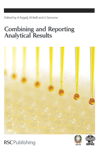 A.
Fajgelj, M. Belli,
and Umberto Sansone
(eds.)
A.
Fajgelj, M. Belli,
and Umberto Sansone
(eds.)
The Royal Society of Chemistry, 2006
[ISBN 0 85404 848 0; ISBN-13
978 0 85404 848 9]
This book contains lectures presented at the international workshop
on "Combining and
Reporting Analytical Results - The Role of (metrological) Traceability
and (measurement) Uncertainty for Comparing Analytical Results",
held from 6 to 8 March 2006 in Rome, Italy. The IUPAC Interdivisional
Working Party on Harmonization of Quality Assurance and the Italian
Agency for Environmental Protection and Technical Services have cooperated
in organization of this event.
The idea for this workshop originated from editors' long term experience
and observations at various meetings of different technical/scientific
organizations and groups, where analytical (measurement) results are
considered. Almost all organizations face similar problems when the
analytical results are to be combined and reported, regardless of their
"metrological level", being a field laboratory, producer of
reference materials, proficiency testing organizer or even a national
metrology institute. Combining measurement results obtained by one analyst
in one laboratory employing one measurement procedure, using one measurement
technique is the starting point, and the two questions: "How to
report the associated measurement uncertainty and how to establish and
demonstrate the metrological traceability of combined results?"
are the major points of concern. The complexity of these questions expands
with the increasing number of measurement procedure/techniques, number
of laboratories and measurement results that need to be considered.
The problems described are not at all new. In recent years, however,
in following the latest developments on the international measurement
scene, in fulfilling requirements for laboratory accreditation according
to international standards, e.g. ISO/IEC 17025, as well as ISO Guides
34, and 43 related to formal demonstration of competence of reference
materials producers and proficiency testing organizers, more attention
has been paid to metrological traceability and measurement uncertainty
as two important quality components of measurement results. A wide international
interest in the topics covered by the workshop program is reflected
in the number of cosponsoring organizations, namely: Centro Svillupo
Materiali. S.p.A (CMS), the International Atomic Energy Agency (IAEA),
the Consultative Committee for Amount of Substance - Metrology in Chemistry
(CCQM), International Bureau of Weights and Measures (BIPM), the Co-operation
on International Traceability in Analytical Chemistry (CITAC), the ISO
Committee on Reference Materials (ISO REMCO) and the United Nations
Industrial Development Organization (UNIDO). All these organizations
were represented by speakers at the workshop and have contributed papers
for this book.
The contributions in this book provide an overview of current practices
used in different laboratories from different scientific fields to combine
and report measurement results, at the same time describing some basic
scientific considerations as well as discussions related to legislative
aspects. Practical examples from, environmental monitoring laboratories,
reference material producers, clinical chemistry, as well as from the
top metrological level, e.g. key comparisons and pilot studies organized
in support and to enable comparability of measurement and calibration
results at world-wide level, are included. The contributions in this
book were prepared by scientists from laboratories dealing daily with
sets of measurement results, their combination and reporting. We hope
that the reader will be able to extract information for her/his own
specific case and be able to apply it in practice. Taking into account
that there will never be only one way of combining and reporting measurement
results, this book is not a classical text book and critical reading
is required.
This is the sixth book in a series based on the work of the IUPAC
Interdivisional Working
Party on Harmonization of Quality Assurance. Also this time the
IUPAC's role in achieving consensus was followed by bringing together
technical experts so that they could share their experience and expertise.
Co-operation with other organizations is essential for making any significant
progress on an international scale. Besides the above listed co-sponsoring
organizations, substantial support and contribution to the successful
organization of the workshop came this time from the IUPAC Secretariat
and the Analytical Chemistry Division and locally from the Italian Agency
for Environmental Protection and Technical Services (APAT) and Centro
Sviluppo Materiali S.p.A (CSM). We are especially grateful to Ms. S.
Rosamilia, Mr. F. Falcioni, Mr. P. de Zorzi, Ms. G. Gelati, Ms. T. Guagnini
and Mr. F. Babalini for the excellent conditions provided during the
workshop and Mr. A. De Maio, the Director of APAT Environmental Department
for his support.
This book provides
an overview of current practices on calculating, combining and reporting
sets of measurement results, including their associated measurement uncertainty
and deals with the concept of metrological traceability in different measurement
fields, thus enabling the reader to better understand specifics and quality
of his/her own measurement results.
With worked examples
the reader will get an overview of current practices used in laboratories
dealing daily with sets of measurement results, their combination and
reporting. This book will help the reader to extract information for
their own specific case and to critically evaluate the quality of the
data understanding that there will never be only one way of combining
and reporting measurement results.
> Ordering
Information @ RSC.org

